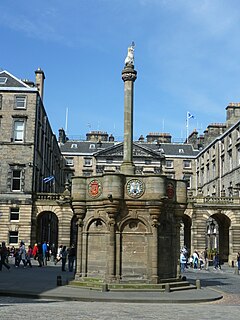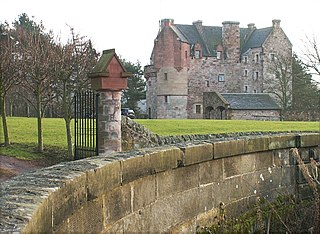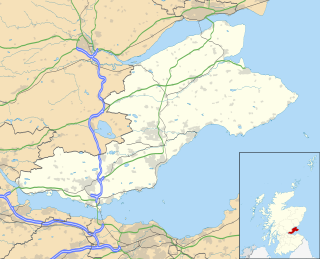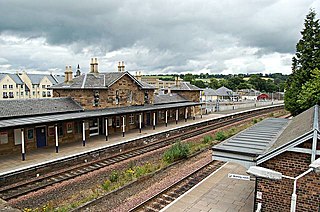This page is based on this
Wikipedia article Text is available under the
CC BY-SA 4.0 license; additional terms may apply.
Images, videos and audio are available under their respective licenses.

Fife is a council area and historic county of Scotland. It is situated between the Firth of Tay and the Firth of Forth, with inland boundaries to Perth and Kinross and Clackmannanshire. By custom it is widely held to have been one of the major Pictish kingdoms, known as Fib, and is still commonly known as the Kingdom of Fife within Scotland. Fife is one of the six local authorities part of the Edinburgh and South East Scotland city region.

A royal burgh was a type of Scottish burgh which had been founded by, or subsequently granted, a royal charter. Although abolished in law in 1975, the term is still used by many former royal burghs.

Cupar is a town 75 kilometres northeast of Regina. Cupar is settled on the flat plains 45 kilometres north of the scenic Qu'Appelle Valley. it is significant for its remarkable hockey history. It is often called the Home of Eddie Shore, as the legendary NHL defenceman was raised here.

North-East Fife was one of three local government districts in the Fife region of Scotland from 1975 - 1996.

Ceres is a village in Fife, Scotland, located in a small glen approximately 2 miles over the Ceres Moor from Cupar and 7 miles from St Andrews. The former parish of that name included the settlements of Baldinnie, Chance Inn, Craigrothie, Pitscottie and Tarvit Mill.

Fife Scottish Omnibuses Ltd, in Scotland, was formed as a bus operating subsidiary of the Scottish Transport Group formed in June 1985 from Walter Alexander & Sons (Fife) Ltd and is now part of the Stagecoach Group, under the control of Stagecoach East Scotland.

Clan MacDuff or Clan Duff is a Lowland Scottish clan. The clan does not currently have a chief and is therefore considered an Armigerous clan, which is registered with the Lyon Court. The early chiefs of Clan MacDuff were the original Earls of Fife, although this title went to the Stewarts of Albany in the late fourteenth century. The title returned to the MacDuff chief when William Duff was made Earl Fife in 1759. His descendant Alexander Duff was made Duke of Fife in 1889.
Melville may refer to the American writer Herman Melville. It may also refer to:

Springfield is a village that lies at the edge of the Howe of Fife, to the south-west of the town of Cupar, Fife, Scotland. The origin of the community is thought to be from the linen industry in the 19th century. The Church of Scotland parish church was built in 1861, and now shares a minister with nearby Ceres and Kemback. The church garden was originally intended to be a cemetery, but the high water table prevented this. The community is surrounded by fields; agriculture is still an important part of the economy of north east Fife.

A mercat cross is the Scots name for the market cross found frequently in Scottish cities, towns and villages where historically the right to hold a regular market or fair was granted by the monarch, a bishop or a baron. It therefore served a secular purpose as a symbol of authority, and was an indication of a burgh's relative prosperity. Historically, the term dates from the period before 1707 when Scotland was an independent kingdom, but it has been applied loosely to later structures built in the traditional architectural style of crosses or structures fulfilling the function of marking a settlement's focal point. Historical documents often refer simply to "the cross" of whichever town or village is mentioned. Today, there are around 126 known examples of extant crosses in Scotland, though the number rises if later imitations are added.

Dairsie, or Osnaburgh, is a village and parish in north-east Fife, Scotland. It is 3 miles (4.8 km) south-southwest of Leuchars Junction, and 3 miles (4.8 km) east-northeast of Cupar on the A91 Stirling to St Andrews road. The village grew out of two smaller settlements, and developed principally around the industry of weaving. Since the late twentieth century it has become a dormitory settlement for nearby towns.
HMS Cupar was a Hunt-class minesweeper of the Royal Navy from World War I. She was originally to be named Rosslare, but was renamed before launch to avoid possible misunderstandings of having vessels named after coastal locations.

The Fife and Forfar Yeomanry (FFY) was an Armoured Yeomanry Regiment of the British Army formed in 1793. It saw action in the Second Boer War, the First World War and the Second World War. It amalgamated with the Scottish Horse to form the Fife and Forfar Yeomanry/Scottish Horse in 1956. The lineage is maintained by "C" Fife and Forfar Yeomanry/Scottish Horse Squadron of The Scottish and North Irish Yeomanry based in Cupar in Fife.

Dysart is a village within the Rural Municipality of Lipton No. 217, in the province of Saskatchewan, Canada. The village is located east of Cupar, and northwest of Lipton. It is about 91 km north of the capital, Regina. The village was named for Dysart, Fife in Scotland.
Balgarvie Castle was located at Balgarvie, near Cupar in Fife, Scotland. The castle was sacked by an English army led by Sir John Pettsworth during the reign of Robert the Bruce (1306–1329). Balgarvie was a possession of the Balfours of Burleigh, and was later sold to the Earl of Melville. It was demolished circa 1938–1940, and there are no remains surviving.
Cupar in Fife was a royal burgh that returned one commissioner to the Parliament of Scotland and to the Convention of Estates.














